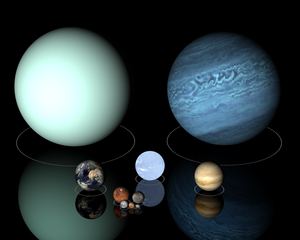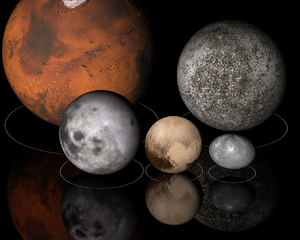Planet
A planet (frae Auncient Greek ἀστὴρ πλανήτης (astēr planētēs), meanin 'wanderin starn') is an astronomical object orbitin a starn or stellar remnant that is massive enough tae be roondit bi its ain gravity, is nae massive enough tae cause thermonuclear fusion, an haes cleared its neighbourin region o planetesimals.[a][1][2] The term planet is auncient, wi ties tae history, science, meethology, an releegion. The planets wur oreeginally seen bi mony early culturs as divine, or as emissaries o deities. As scientific knawledge advanced, human perception o the planets chynged, incorporatin a nummer o disparate objects. In 2006, the Internaitional Astronomical Union (IAU) offeecially adoptit a resolution definin planets within the Solar Seestem. This defineetion haes been baith praised an criticized an remains disputit bi some scientists acause it excludes mony objects o planetary mass based on whaur or whit thay orbit. While aicht o the planetary bodies discovered afore 1950 remain "planets" unner the modren defineetion, some celestial bodies, such as Ceres, Pallas, Juno, Vesta (each an object in the Solar asteroid belt), an Pluto (the first-discovered trans-Neptunian object), that wur ance considered planets bi the scientific community are nae langer viewed as such.
The planets wur thoucht bi Ptolemy tae orbit the Yird in deferent an epicycle motions. Altho the idea that the planets orbitit the Sun haed been suggestit mony times, it wis nae till the 17t century that this view wis supportit bi evidence frae the first telescopic astronomical observations, performed bi Galileo Galilei. Bi careful analysis o the observation data, Johannes Kepler foond the planets' orbits wur nae circular but elliptical. As observational tuils improved, astronomers saw that, lik Yird, the planets rotatit aroond tiltit axes, an some shared such featurs as ice caps an saisons. Syne the dawn o the Space Age, close observation bi probes haes foond that Yird an the ither planets share characteristics such as volcanism, hurricanes, tectonics, an even hydrology.
Planets are generally dividit intae twa main types: lairge, law-density gas giants an smawer, rocky terrestrials. Unner IAU defineetions, thare are aicht planets in the Solar Seestem. In order o increasin distance frae the Sun, thay are the fower terrestrials, Mercur, Venus, Yird, an Maurs, then the fower gas giants, Jupiter, Saturn, Uranus, an Neptune. Sax o the planets are orbitit bi ane or mair naitural satellites.
Addeetionally, altho nae planets, the IAU accepts five dwarf planets,[3] wi mony ithers unner consideration,[4] an hundrits o thoosands o smaa Solar Seestem bodies.
Syne 1992, hundrits o planets aroond ither starns ("extrasolar planets" or "exoplanets") in the Milky Way hae been discovered. As o 16 August 2016, 3,501 kent extrasolar planets (in 2,623 planetary seestems an 592 multiple planetary seestems) are leetit in the Extrasolar Planets Encyclopaedia, rangin in size frae that o terrestrial planets seemilar tae Yird tae that o gas giants lairger than Jupiter.[5] On December 20, 2011, the Kepler Space Telescope team reportit the discovery o the first Yird-sized extrasolar planets, Kepler-20e[6] an Kepler-20f,[7] orbitin a Sun-lik starn, Kepler-20.[8][9][10] A 2012 study, analyzin gravitational microlensin data, estimates an average o at least 1.6 boond planets for every starn in the Milky Way.[11] Astronomers at the Harvard-Smithsonian Center for Astrophysics (CfA) reportit in Januar 2013 that "at least 17 billion" Yird-sized (i.e. 0.8–1.25 Yird masses) exoplanets wi orbital periods o 85 days or less are estimatit tae reside in the Milky Way Galaxy.[12]
Notes[eedit | eedit soorce]
- ↑ This defineetion is drawn frae twa separate IAU declarations; a formal definition agreed bi the IAU in 2006, an an informal wirkin defineetion established bi the IAU in 2001/2003 for objects ootside o the Solar Seestem. The 2006 defineetion, while offeecial, applies anly tae the Solar Seestem, while the 2003 defineetion applies tae planets aroond ither starns. The extrasolar planet issue was deemed too complex tae resolve at the 2006 IAU conference.
References[eedit | eedit soorce]
- ↑ "IAU 2006 General Assembly: Result of the IAU Resolution votes". International Astronomical Union. 2006. Retrieved 30 December 2009.
- ↑ "Working Group on Extrasolar Planets (WGESP) of the International Astronomical Union". IAU. 2001. Retrieved 23 August 2008.
- ↑ Ceres, Pluto (oreeginally classified as the Solar Seestem's ninth planet), Makemake, Haumea an Eris
- ↑ "Pluto and the Solar System". IAU. Retrieved 1 August 2013.
- ↑ Schneider, Jean (16 Januar 2013). "Interactive Extra-solar Planets Catalog". The Extrasolar Planets Encyclopaedia. Retrieved 15 Januar 2013.
- ↑ NASA Staff (20 December 2011). "Kepler: A Search For Habitable Planets – Kepler-20e". NASA. Archived frae the original on 31 Mairch 2017. Retrieved 23 December 2011.
- ↑ NASA Staff (20 December 2011). "Kepler: A Search For Habitable Planets – Kepler-20f". NASA. Archived frae the original on 14 Juin 2012. Retrieved 23 December 2011.
- ↑ Johnson, Michele (20 December 2011). "NASA Discovers First Earth-size Planets Beyond Our Solar System". NASA. Archived frae the original on 4 Mey 2019. Retrieved 20 December 2011.
- ↑ Hand, Eric (20 December 2011). "Kepler discovers first Earth-sized exoplanets". Nature. doi:10.1038/nature.2011.9688.
- ↑ Overbye, Dennis (20 December 2011). "Two Earth-Size Planets Are Discovered". New York Times. Retrieved 21 December 2011.
- ↑ Cassan, Arnaud (12 Januar 2012). "One or more bound planets per Milky Way star from microlensing observations". Nature. 481 (7380): 167–169. arXiv:1202.0903. Bibcode:2012Natur.481..167C. doi:10.1038/nature10684. PMID 22237108. Retrieved 11 Januar 2012. Unknown parameter
|coauthors=ignored (|author=suggested) (help) - ↑ Staff (7 Januar 2013). "17 Billion Earth-Size Alien Planets Inhabit Milky Way". Space.com. Retrieved 8 Januar 2013.


